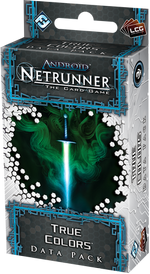- See also the List of cards in True Colors and True Colors category
CONTAINS CARDS 61-80 of the "SPIN CYCLE."
True Colors is the fourth Data Pack in the Spin Cycle.
There are three realities in the world of Android: Netrunner.
You have the meat world. There, Corps are massive conglomerations, comprised of thousands of individuals, all housed in towers of glass, steel, and plascrete, and Runners are like all other mortals, needing to eat and breathe and sleep. Then, you have the virtual world where Corps are massive, hulking fortresses, with layers and layers of ice, and Runners may crack them open with keys, black holes, or solar flares. Finally, you have a third, equally important reality: the realm of public perception.
In True Colors, the fourth Data Pack in the Spin Cycle, the Corps and Runners of Android: Netrunner struggle to control the flow of information in three realities – the physical world, the virtual world, and the world of public perception. Sixty new cards reinforce each faction’s core strengths and add layers upon layers of bluffs and deception. With a host of cards to manipulate tags and bad publicity, True Colors brings the game’s high stakes cybercrime more fully into the public eye than ever before. Can you separate the truth from the spin?
| Set # | Name | Faction | Type |
|---|---|---|---|
| 61 | Keyhole | Anarch | Program |
| 62 | Activist Support | Anarch | Resource |
| 63 | Lawyer Up | Criminal | Event |
| 64 | Leverage | Criminal | Event |
| 65 | Garrote | Criminal | Program |
| 66 | LLDS Processor | Shaper | Hardware |
| 67 | Sharpshooter | Shaper | Program |
| 68 | ◆Capstone | Shaper | Hardware |
| 69 | Starlight Crusade Funding | Neutral | Resource |
| 70 | Rex Campaign | Haas-Bioroid | Asset |
| 71 | Fenris | Haas-Bioroid | Ice |
| 72 | Panic Button | Haas-Bioroid | Upgrade |
| 73 | Shock! | Jinteki | Asset |
| 74 | Tsurugi | Jinteki | Ice |
| 75 | TGTBT | NBN | Agenda |
| 76 | Sweeps Week | NBN | Operation |
| 77 | RSVP | NBN | Ice |
| 78 | Curtain Wall | Weyland Consortium | Ice |
| 79 | Punitive Counterstrike | Weyland Consortium | Operation |
| 80 | Veterans Program | Neutral | Agenda |
| Flavor Insert |
|---|
Veterans face a new challenge By Carlos Ochoa Marshall Johns (alias) wakes up at 0200 each morning with a throbbing pain in his frontal cortex. This is when his prescription mycodin wears off. It gets progressively worse, until he describes it as "a raging fire." At 0800, he grabs the pill delivered daily to his box, and the pain subsides. But the mycodin is losing its effectiveness. Last month he woke up at 0245. The month before, 0300. He worries that his claim for a different analgesic will not be granted. He worries what he might do. He worries that he might not make it to his 26th birthday, just three months away. In some ways, Marshall is the lucky one. For every vet that receives some sort of medical assistance from the government, two more do not. Medical claims have gone up every year since the treaty, hitting an all-time high this year. It has been estimated that almost a third of them are brain-related. Less than half of them are granted. June Summers (real name) from the VHA says that these numbers are misleading. "We resolve all legitimate claims. There are a high number of fraudulent claims that are entered into the system." She had no comment about their approval process. The effects of cyber-warfare on the brain are not well documented. The public perception that most of the war was fought from the back lines does little to aid the plight of those who were exposed to high-density e-waves. One veteran, Meghan Lorry (alias), a Master Sergeant in the Electronic Warfare Service stationed in near-Earth orbit, said that her unit sent out over 72 zettabytes of military-grade "warp" waves each day, mostly from drones. Over 40% of her unit reported migraines over the course of her first duty, though she was not affected. "The warp was not even our most useful AP weapon, though it was the most proven," Meghan tells us. "We were taught how to unleash it, not how to rein it in." She refuses to talk in detail about, any other devices that were employed. "People think we were fighting sortie parallel, almost fake cyber-war. They couldn't be more wrong. If you jack into a drone, you might get spiked or flatlined." The technology might still be classified, but the effects are no longer military secrets. Those coming home from off-world have had the highest incidence of disability claims, like Marshall Johns. He was drop-shipped into Planum Boreum, right in the thick of the fighting. His standard-issue nanotic helmet was a hindrance to him on Mars; now it sits on his night stand. “I was careless," he recalls. "None of us thought it mattered. We didn't keep them on. Now we are paying the price." Sometimes he |

